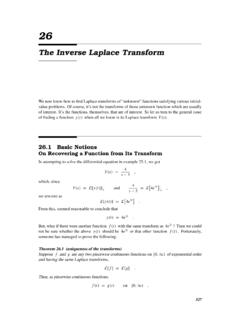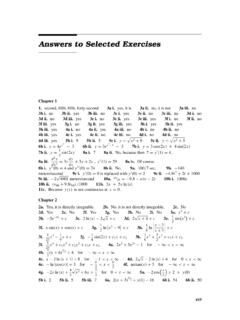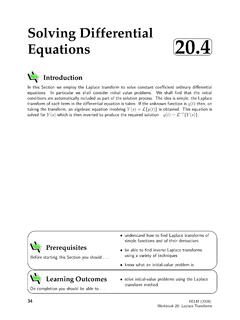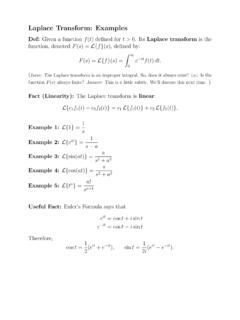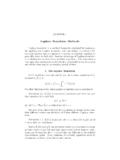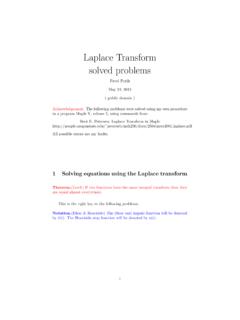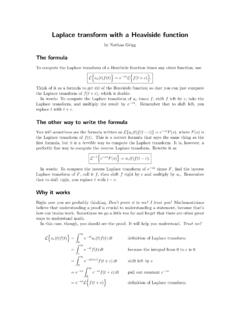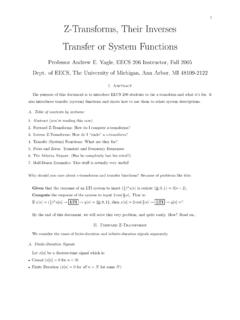Transcription of Differentiation and the Laplace Transform
1 25 Differentiation and the LaplaceTransformIn this chapter, we explore how the Laplace Transform interacts with the basic operators ofcalculus: Differentiation and integration. The greatest interest will be in the first identity thatwe will derive. This relates the Transform of a derivative ofa function to the Transform ofthe original function, and will allow us to convert many initial-value problems to easily solvedalgebraic equations. But there are other useful relations involving the Laplace Transform andeither Differentiation or integration. So we ll look at them, Transforms of DerivativesThe Main IdentityTo see how the Laplace Transform can convert a differential equation to a simple algebraicequation, let us examine how the Transform of a function s derivative,L f (t) s=L d fdt s=Z 0d fdte stdt=Z 0e std fdtdt,is related to the corresponding Transform of the original function,F(s)=L[f(t)]|s=Z 0f(t)e last formula above forL f (t) clearly suggests using integration by parts, and to ensurethat this integration by parts is valid, we need to assumefis continuous on[0, )andf isat least piecewise continuous on(0, ).]
2 Assuming this,L f (t) s=Z 0e st|{z}ud fdtdt|{z}dv=uv t=0 Z 0vdu=e stf(t) t=0 Z 0f(t) se st dt507508 Differentiation and the Laplace Transform =limt e stf(t) e s 0f(0) Z 0 se st f(t)dt=limt e stf(t) f(0)+sZ 0f(t)e , iffis of exponential orders0, thenlimt e stf(t)=0whenevers>s0andF(s)=L[f(t)]|s=Z 0f(t)e stdtexists fors> , continuing the above computations forL f (t) withs>s0, we find thatL f (t) s=limt e stf(t) f(0)+sZ 0f(t)e stdt=0 f(0)+sL[f(t)]|s,which is a little more conveniently written asL f (t) s=sL[f(t)]|s f(0)( )or even asL f (t) s=sF(s) f(0).( )This will be a very useful result, well worth preserving in a ( Transform of a derivative)LetF=L[f]wherefis a continuous function of exponential orders0on[0, ). Iff isat least piecewise continuous on(0, ), thenL f (t) s=sF(s) f(0)fors> these identities to formulas for the transforms of higher derivatives is easy.]
3 First,for convenience, rewrite equation ( ) asL g (t) s=sL[g(t)]|s g(0)or, equivalently, asL dgdt s=sL[g(t)]|s g(0).(Keep in mind that this assumesgis a continuous function of exponential order,g is piecewisecontinuous andsis larger than the order ofg.) Now we simply apply this equation withg=f ,g=f , etc. Assuming all the functions are sufficiently continuous and are of exponential order,we see thatL f (t) s=L d f dt s=sL f (t) s f (0)=s[sF(s) f(0)] f (0)=s2F(s) s f(0) f (0).Transforms of Derivatives509 Using this, we then see thatL f (t) s=L d f dt s=sL f (t) s f (0)=s s2F(s) s f(0) f (0) f (0)=s3F(s) s2f(0) s f (0) f (0).Clearly, if we continue, we will end up with the following corollary to theorem :Corollary (transforms of derivatives)LetF=L[f]wherefis a continuous function of exponential orders0on[0, ).]
4 Iff isat least piecewise continuous on(0, ), thenL f (t) s=sF(s) f(0)fors> , in addition,f is a continuous function of exponential orders0, andf is at least piecewisecontinuous, thenL f (t) s=s2F(s) s f(0) f (0)fors> generally, iff,f ,f , .., andf(n 1)are all continuous functions of exponential orders0on[0, )for some positive integern, andf(n)is at least piecewise continuous on(0, ),then, fors>s0,L f(n)(t) s=snF(s) sn 1f(0) sn 2f (0) sn 3f (0) s f(n 2)(0) f(n 1)(0).Using the Main IdentityLet us now see how these identities can be used in solving initial-value problems. We ll startwith something simple:! Example :Consider the initial-value problemdydt 3y=0withy(0)= what happens when we take the Laplace Transform of the differential equation ( ,we take the Transform of both sides). Initially, we just haveL dydt 3y s=L[0]| the linearity of the Transform and fact thatL[0]=0, this is the same asL dydt s 3L[y]|s= and the Laplace TransformLettingY=L[y]and applying the Transform of the derivative identity (theorem ,above), our equation becomes sY(s) y(0) 3Y(s)=0,which, since the initial condition isy(0)=4, can be rewritten assY(s) 4 3Y(s)= is a simple algebraic equation that we can easily solve forY(s).]
5 First, gather theY(s)terms together and add4to both sides,[s 3]Y(s)=4,and then divide through bys 3,Y(s)=4s , we have the Laplace transformYof the solutionyto the original initial-valueproblem. Of course, it would be nice if we can recover the formula fory(t)fromY(s). Andthis is fairly easy done, provided we remember that4s 3=4 1s 3=4L e3t s=L 4e3t the last two equations with the definition ofY, we now haveL[y(t)]|s=Y(s)=4s 3=L 4e3t is,L[y(t)]=L 4e3t ,from which it seems reasonable to expecty(t)= will confirm that this is valid reasoning when we discuss the inverse Laplace Transform in the next general, it is fairly easy to find the Laplace Transform of the solution to an initial-valueproblem involving a linear differential equation with constant coefficients and a reasonable forcing function1.
6 Simply take the Transform of both sides of the differentialequation involved,apply the basic identities, avoid getting lost in the bookkeeping, and solve the resulting simplealgebraic equation for the unknown function ofs. But keep in mind that this is just the LaplacetransformY(s)of the solutiony(t)to the original problem. Recoveringy(t)from theY(s)found will usually not be as simple as in the last example. We ll discuss this (the recovering ofy(t)fromY(s)) in greater detail in the next chapter. For now, let us just practice finding the Y(s) . , a forcing function whose Transform is easily computedTransforms of Derivatives511! Example :Let s find the Laplace transformY(s)=L[y(t)]|swhenyis the solutionto the initial-value problemy 7y +12y=16e2twithy(0)=6andy (0)= the Transform of the equation and proceeding as in thelast example:L y 7y +12y s=L 16e2t s L y s 7L y s+12L[y]|s=16L e2t s s2Y(s) sy(0) y (0) 7 sY(s) y(0) +12Y(s)=16s 2 s2Y(s) s6 4 7 sY(s) 6 +12Y(s)=16s 2 s2Y(s) 6s 4 7sY(s)+7 6+12Y(s)=16s 2 s2 7s+12 Y(s) 6s+38=16s 2 s2 7s+12 Y(s)=16s 2+6s ,Y(s)=16(s 2)(s2 7s+12)+6s 38s2 7s+12.
7 ( )If desired, we can obtain a slightly more concise expressionforY(s)by finding thecommon denominator and adding the two terms on the right,Y(s)=16(s 2)(s2 7s+12)+(s 2)(6s 38)(s 2) s2 7s+12 ,obtainingY(s)=6s2 50s+92(s 2) s2 7s+12 .( )We will finish solving the above initial-value problem in example on page 533. At thattime, we will find the later expression forY(s)to be more convenient. At this point, though,there is no significant advantage gained by reducing expression ( ) to ( ). When doingsimilar problems in the exercises, go ahead and find the common denominator and add ifthe algebra is relatively simple. Otherwise, leave your answers as the sum of two , do observe that we didNOTmultiply out the factors in the denominator, butleft them as(s 2) s2 7s+12 .512 Differentiation and the Laplace TransformDo the same in your own work.
8 In the next chapter, we will see that leaving the denominatorin factored form will simplify the task of recoveringy(t)fromY(s). Derivatives of TransformsIn addition to the transforms of derivatives identities just discussed, there are some derivativesof transforms identities worth discussing. To derive the basic identity, we start with a generictransform,F(s)=L[f(t)]|s=Z 0f(t)e stdt,and (naively) look at its derivative,F (s)=dFds=ddsZ 0f(t)e stdt=Z 0 se stf(t)dt=Z 0( t)e stf(t)dt= Z 0t f(t)e stdt|{z}L[t f(t)]| out the middle of the above set of equalities gives usthe identitydFds= L[t f(t)]| we will often use this identity to compute transforms of functions multiplied byt, let smove the negative sign to the other side and rewrite this identity asL[t f(t)]|s= dFdsor, equivalently, asL[t f(t)]|s= ddsL[f(t)]| cautious reader may be concerned about the validity ofddsZ 0g(t,s)dt=Z 0 s[g(t,s)]dt,blithely used (withg(t,s)=e stf(t))
9 In the above derivation This is a legitimate concern, andis why we must consider the above a somewhat naive derivation, instead of a truly rigorousone. Fortunately, the above derivations can be rigorously verified wheneverfis of exponentialorders0and we restrictsto being greater thans0. This gives the following theorem:Theorem (derivatives of transforms)LetF=L[f]wherefis a piecewise continuous function of exponential orders0on(0, ).ThenF(s)is differentiable ons>s0, andL[t f(t)]|s= dFdsfors>s0.( )Derivatives of Transforms513A rigorous proof of this theorem is not hard, but is a bit longer than our naive interested reader can find it in the appendix starting on page 519 Now let s try using our new identity.! Example :Find the Laplace Transform oftsin(3t). Here, we haveL[tsin(3t)]|s=L[t f(t)]|s= dFdswithf(t)=sin(3t).
10 From the tables (or memory), we find thatF(s)=L[f(t)]|s=L[sin(3t)]|s=3s2+ the identity just derived (identity ( )) yieldsL[tsin(3t)]|s=L[t f(t)]|s= dFds= dds 3s2+9 = 3 2s s2+9 2=6s s2+9 corresponding identities involving higher orderderivatives and higher powers oftis straightforward. Simply use the identity in theorem , replacingf(t)witht f(t),t2f(t), etc.:L t2f(t) s=L t[t f(t)] s= ddsL[t f(t)]|s= dds dFds =( 1)2d2 Fds2,L t3f(t) s=L t[t2f(t)] s= ddsL t2f(t) s= dds ( 1)2d2 Fds2 =( 1)3d3 Fds3,L t4f(t) s=L t[t3f(t)] s= ddsL t3f(t) s= dds ( 1)3d3 Fds3 =( 1)4d4 Fds4,and so on. Clearly, then, as a corollary to theorem , we have:Corollary (derivatives of transforms)LetF=L[f]wherefis a piecewise continuous function of exponential orders0. ThenF(s)is infinitely differentiable fors>s0, andL tnf(t) s=( 1)ndnFdsnforn=1,2,3.
